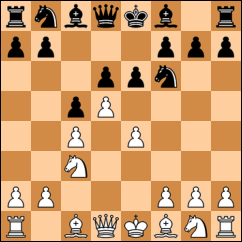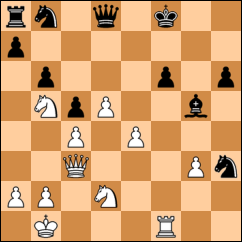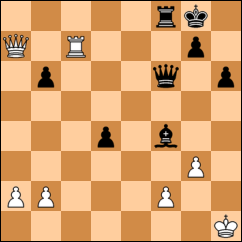K.Ammann–G.SargentRoute 20 Chess Club
Freeport, Ill., May 27, 2011
1.d4 Nf6 2.c4 e6 3.Nc3 c5!?
A Modern Benoni. Reminding me that sooner or later I need to get around to reading about Benonis.
4.d5 d6 5.e4
5...Be7 6.Qa4+ Bd7 7.Qb3 b6 8.f4 0-0 9.Nf3
I'm feeling pretty good about my development, even though both my bishops are still sitting on their starting squares. Gary's are both more or less incapacitated at the moment, so I figure my knights are stronger. Of course, he's not going to let them stay incapacitated.
9...Ng4
Gary might also free his better bishop by opening the center up a bit with 9...exd5 10.cxd5 Re8.
10.Qc2
Not wanting to allow a sacrifice invasion on f2 to dislodge my king. Is this something I should be worried about? Probably not.
10...Bh4+ 11.g3 Bf6
Not bad for me.
12.h3
12.e5 is a little better. Still, it's nice to be sending Gary's active knight into exile on the rim.
12...Nh6 13.Be3 e5?
Allows me to blow up half the kingside with 14.fxe5 Bxe5 15.Nxe5 dxe5 16.Bxh6 gxh6 before castling queenside. If, you know, I should happen to think of it.
14.0-0-0 exf4 15.Bxf4 g5
Apparently missing the threat against his rook after 16.Bxd6. 15...Re8 makes the invasion less desirable, as white has to be content with positional compensation after 16.Bxd6?! Bxc3 17.Qxc3 Ba4 18.Bxb8 Bxd1.
16.Bxd6 g4??
16...Ba4 17.Qxa4 Qxd6 removes the invader with the least collateral damage.
17.Bxd8 Kxf8
18.Nd2
It's not horrible, but I'm going to regret putting this knight here.
18...Bg5 19.Be2
Wanting to develop my last undeveloped piece and connect my rooks. But 19.e5 is very big here.
19...gxh3 20.Nb5
20.Rdf1 is pretty sweet here, as is breaking the pin with 20.Kb1. Really, I have no excuse for putting off the king move as long as I do.
20...Bg4 21.Bxg4 Nxg4 22.Rxh3 h6 23.Qc3
I already see that the knight is going to be a threat, and I'm trying to maneuver into position to stop it, but my pieces are tripping over each other. Stupid pinned knight.
23...f6 24.Kb1
I have waited to make this king move until the moment is . . . totally wrong.
24...Nf2
Dagnabbit! I saw this coming, and I flaked on it. (24.Rf1!? would have immunized me.)
25.Rf1
It's like I'm just not paying attention now. The rook I should be trying to save is the one on h3. Of course, I clearly can't let Gary play ...Nxd1, because then he gains a tempo off my queen. The conclusion I should come to is 25.Rdh1 Nxh3 26.Rxh3.
25...Nxh3
26.Nc7??
I'm thinking I'm being clever here: distract the queen away from d8 with a threat against the rook, then sacrifice my rook for a breakthrough on f6: 26...Qxc7 27.Rxf6+ Bxf6 28.Qxf6+. But there's no follow-through, so eventually the attack is going to fizzle, and I'll be down a rook for a pawn (I can even up the minor-piece score by choosing the continuation 28...Kg8 29.Qe6+ Kg7 Qxh3). Luckily for me, Gary tries to get clever too.
26...Bxd2??
It so happens that I now have a forced mate in 11: 27.Rxf6+ Ke7 28.Qe5+ Kd7 29.Rf7+ Kc8 30.Ne6 Bf4 31.gxf4 Nd7 32.Qd6 h5 33.Nxd8 Nxf4 34.Qxd7+ Kb8 35.Nc6#. Yeah, like I'm going to notice mate in 11.
27.Qxd2 Ng5 28.Nxa8 Nd7 29.Nxb6?! axb6 30.a4
30.Qh2 Kg7 31.Rh1 is a line I should be investigating. Instead, I'm marching steadfastly toward a likely draw.
30...Kg7 31.Qf4 Qe7
The pawn on e4 is getting a lot of attention. I hope it's not shy.
32.Qg4
I'm thinking that if we end up trading queens, a rook and a passed pawn against two knights may be salvageable, but what I don't want is the exchange on e4 to be initiated by the knight and end with a queen check against me. So I decide to pin the knight. And what's my plan in case of 32...h5 ? Ermmm . . .
32...Ne5 33.Qe2 Qa7
32...Qd7!?, threatening 33...Qh3, is quite good for Gary.
34.b3 Qa5 35.Kc2 Qb4
It's better to break up my pawn chain first with 35...b5 36.cxb5.
36.d6??
When Fritz told me this was a blunder, I was surprised. The problem with it is that it allows 36...Ne6!!, threatening a royal fork on d4. I have to blow two moves, one to save the queen, the other to get out of check, thereby allowing Gary to terminate my backward b-pawn (one potential line: 37.Qd1 Nd4+ 38.Kb1 Nxb3). After that, all I can do is desperately push my d-pawn, in which case Gary cuts off its protection with discovered check (39.d7 Nd4+), then snuffs it out (40.Kb1 Nxd7). Damn.
So what's the alternative? 36.Kb2 keeps the white king and queen out of forkable position, while also ensuring that the black queen has no way into white's territory, and maintains winning chances for white. Anything else favors black.
36...Nef3 37.Rxf3! 1-0
If the knight retakes, it's curtains for black (38.Qxf3 Qa3 39.Kb1 Qb4 40.Qd1 b5 41.d7 bxa4 42.d8Q Qxb3+ 43.Qxb3). If black attempts the ...Ne6 trick now, the sixth-rank passed pawn takes all the joy out of it (38.d7 Nd4+ 39.Kb2 Nxf3/Nxe2 40.d8Q). If black tries to slip his queen into white's territory with 38...Qa3, 39.Kb1 puts the kibosh on that plan (the f3-rook prevents ...Qxb3). White can effectively ignore black's best reply, 37...b5, by shifting his rook over to the d-file, opening up a diagonal through which his queen can fork king and knight (39.Rd3 bxc4 40.Qg4+ Kh7 41.Qxe6). Go ahead -- try and stop that pawn from promoting now.


















